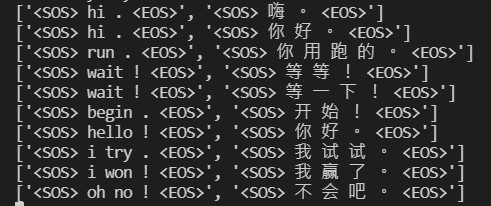[神经机器翻译理论与实作] 从头建立英中文翻译器 (I)
前言
从今天起,我们将实地建立英文到中文的翻译神经网络,今天先从语料库到文本前处理开始。
翻译器建立实作
从语料库到建立资料集
在这里我们由公开的平行语料库来源网站选定下载英文-中文语料库:Tab-delimited Bilingual Sentence Pairs

原始语料库档案如下:

首先,我们载入语料库档案,并以 list 物件来存取每一列文字:
import re
import pickle as pkl
data_path = "data/raw_parallel_corpora/eng-cn.txt"
with open(data_path, 'r', encoding = "utf-8") as f:
lines = f.read().split('\n')
我们将每列的句子依照不同语言分开,并且进行前处理(小写转换、去除多余空白、并切开将每个单词与标点符号),最後加入文句起始标示 <SOS> 与结尾标示 <EOS> 。由於书写习惯的不同,中文和英文的前处理需要分开处理(或是英文-德文等相同语系就不必分开定义两个函式):
def preprocess_cn(sentence):
"""
Lowercases a Chinese sentence and inserts a whitespace between two characters.
Surrounds the split sentence with <SOS> and <EOS>.
"""
# removes whitespaces from the beginning of a sentence and from the end of a sentence
sentence = sentence.lower().strip()
# removes redundant whitespaces among words
sentence = re.sub(r"[' ']+", " ", sentence)
sentence = sentence.strip()
# inserts a whitespace in between two words
sentence = " ".join(sentence)
# attaches starting token and ending token
sentence = "<SOS> " + sentence + " <EOS>"
return sentence
def preprocess_eng(sentence):
"""
Lowercases an English sentence and inserts a whitespace within 2 words or punctuations.
Surrounds the split sentence with <SOS> and <EOS>
"""
sentence = sentence.lower().strip()
sentence = re.sub(r"([,.!?\"'])", r" \1", sentence)
sentence = re.sub(r"\s+", " ", sentence)
sentence = re.sub(r"[^a-zA-Z,.!?\"']", ' ', sentence)
sentence = "<SOS> " + sentence + " <EOS>"
return sentence
接着将每一列文字分别存入 seq_pairs 中:
# regardless of source and target languages
seq_pairs = []
for line in lines:
# ensures that the line loaded contains Chinese and English sentences
if len(line.split('\t')) >= 3:
eng_doc, cn_doc, _ = line.split('\t')
eng_doc = preprocess_eng(eng_doc)
en_doc = preprocess_cn(tgt_doc)
seq_pairs.append([eng_doc, en_doc])
else:
continue
我们检视一下前十笔经过前处理的英文-中文序列:

在正式建立资料集之前,我们将前处理後的双语分别写入 pkl 档,以便後续建立资料集时直接使用,且可以依自己的喜好指定语中文或英文为来源或目标语言。
# Save list seq_pairs to file
with open("data/eng-cn.pkl", "wb") as f:
pkl.dump(seq_pairs, f)
在此次的翻译实战中,我将中文设定为输入语言(来源语言)而英文设定为输出语言(目标语言)。
假设今天在另一个程序中,我们可以从 pkl 档案读取出刚才处理好的字串,并且依照来源语言以及目标语言写入文件中:
# Retrieve pickle file of sequence pairs
with open("data/eng-cn.pkl", "rb") as f:
seq_pairs = pkl.load(f)
# text corpora (source: English, target: Chinese)
src_docs = []
tgt_docs = []
src_tokens = []
tgt_tokens = []
for pair in seq_pairs:
src_doc, tgt_doc = pair
# English sentence
src_docs.append(src_doc)
# Chinese sentence
tgt_docs.append(tgt_doc)
# tokenisation
for token in src_doc.split():
if token not in src_tokens:
src_tokens.append(token)
for token in tgt_doc.split():
if token not in tgt_tokens:
tgt_tokens.append(token)
今天的进度就到这边,明天接着继续建立训练资料集!各位小夥伴晚安!
阅读更多
- How to Develop a Neural Machine Translation System from Scratch
- Seq2Seq Learning & Neural Machine Translation
>>: 连续 30 天 玩玩看 ProtoPie - Day 20
Day-8:Rails的CRUD
CRUD系虾米? CRUD即为Create、Read、Update、Delete等四项基本资料库操作...
Day 14: Structural patterns - Decorator
目的 使用包覆(Wrapper)的方式,可以动态地给物件增添新的功能,或是重新定义既有的功能,达到扩...
Day 7 | 清单元件 - 纯文字
Adapter 一笔资讯的内容称为项目(Item),而负责将资料转换成资讯的就是Adapter,Ad...
Day32 参加职训(机器学习与资料分析工程师培训班),tf.keras
今日练习内容为建构CNN模型来分类鸟类图片,最後讲解一些架构的演进 # Load Data &...
管理是什麽?
What is management? 如果有人问你,「一个主管的工作到底是什麽?」,你会怎麽说? ...